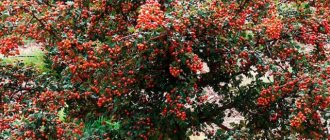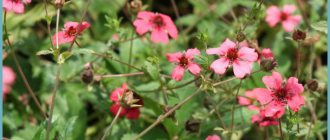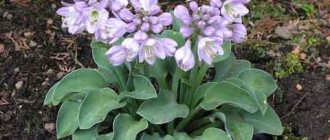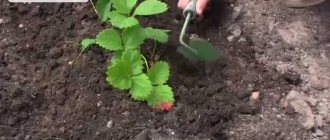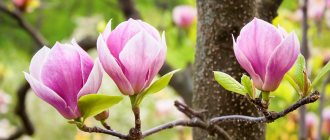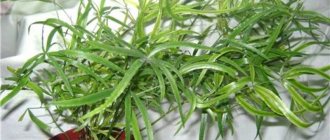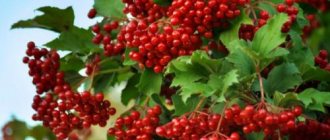The following pests are dangerous:
How to fight these diseases and pests?
- Powdery mildew . It looks like a coating located on the leaves and shoots. After some time, the leaves begin to curl and the shoots begin to deform. To get rid of powdery mildew, the shoots must be removed and the leaves sprayed with Vectr or Cumulus. After two weeks, the procedure must be repeated again.
Brown, white, yellow and gray spotting . Brown spot appears as brown spots on the leaves. Over time, the leaves begin to dry out. Ocher spotting appears as brown spots on leaf blades. This leads to the leaves drying out and falling off.
Propagation of hawthorn by seeds and cuttings
Propagation of hawthorn by cuttings is a very long and complex process. Cuttings must be done in the spring before the sap flows. Cuttings are green annual shoots. The cuttings must be cut diagonally under the bud. After this, they need to be placed in a rooter for an hour. Then the cuttings need to be planted in prepared soil.
The soil should be loose. To do this, it must be mixed with peat and sand. The soil needs to be watered with rooting agent, and then the cuttings can be planted. The distance between them should be at least twenty centimeters. In order for cuttings to germinate, constant high humidity must be maintained.
Rooted cuttings can be transplanted to a new location after a year. The distance between them should be about two meters. To prevent seedlings from dying, do not forget about the rules of care.
Growing hawthorn from root cuttings
Root cuttings are considered the most effective way to propagate large-fruited hawthorn. Root cuttings take root easily and produce strong, high-quality shoots. Hawthorn can be propagated both in autumn and spring.
With the arrival of spring, they dig up a shrub suitable for propagation, with a good root system, which is cleared of soil and cut into pieces 8 cm long. Each root is partially sprinkled with earth, leaving no more than 2 cm on the surface. To slow down the evaporation of moisture, the soil around the buried roots mulch with sawdust, shavings, sand, hay, straw. To protect future shoots and create greenhouse conditions with high levels of air humidity, root cuttings are covered with plastic bottles or other similar means.
To propagate hawthorn by root cuttings in the fall, the root of the selected shrub is divided into 15 cm long segments and placed in the soil obliquely at an angle.
Propagation from seeds at home
Under natural conditions, hawthorn reproduces by seeds, but doing this at home is not so easy.
To germinate seeds, they must first be collected. Then soak for two hours in sulfuric acid or saline solution. After two hours, the seeds should be washed in cool water and can be planted in prepared soil.
There is another way. Collect the seeds and place them in a cloth bag. Then they should be placed in boiling water for thirty seconds, and then in cold water. This alternation must be repeated until the seeds swell. Now they can be planted.
Planted seeds need to be watered and covered with straw. In this state, the seeds should be left throughout the winter. In spring, the seeds need to be opened. Shoots should appear that will grow very slowly, no more than ten centimeters per year. When the seedling reaches the desired size, it can be transplanted into open ground.
Growing hawthorn: 300 years without special care
Hawthorn is very unpretentious, grows on poor soils and in places with poor ecology. It easily tolerates both excess and lack of moisture and light, and does not freeze in harsh winters.
During periods of prolonged drought, the leaves curl and dry out, and come to life again after rain. I have hawthorn growing in three different places on my property. Near the pump there is already a tree about 5 meters high, near the road there are beautiful fluffy bushes, and near the fence, under the poplar, the hawthorn develops worse, blooms poorly, does not bear fruit at all, it is much lower than its fellows planted at the same time. Practice shows that in more favorable conditions, hawthorn develops better.
Hawthorn has a very powerful root system, and it lives for 300-400 years.
Once again I want to emphasize that it is very beautiful all year round. In winter, bushes and small trees shed their leaves, and their branches look very beautiful - purple-brown, shiny, lined with thick, up to 10 cm, thorns. These spines are not fully formed shoots. Tiny leaves grow on them, but they soon die off. The spines are as hard as nails. During the period when there are no flowers yet, hawthorn is good for its interesting leaf shape. Then flowers appear - white, not double, not particularly chic, collected in umbrellas, somewhat similar to rowan flowers, only larger. The smell is not for everyone.
The benefits and harms of hawthorn
So, now you know everything about planting and caring for hawthorn, how to grow and propagate this plant, the rules of pruning, diseases and pests that can attack the tree and the rules for combating them, and you also learned what benefits this tree brings.
Hawthorn grows as shrubs of great height. The plant has become widespread in decorative design.
Hawthorn is also used for medicinal purposes due to its beneficial properties. Hawthorn berries are eaten.
This article will provide a description of hawthorn, varieties and its beneficial qualities. Let's look at tips for planting, growing and caring for this plant and much more.
Popular varieties
- Crimean variety - this species grows in rocky soil, has low bushes, and cherry-colored fruits.
- Chinese variety - grows mainly in China and in other countries along river banks, reaching a height of five meters.
- A softish variety - grows in the USA on the edges of forests, the berries are orange in color.
- Variety "Arnold" - is distinguished by high fruitfulness and large leaves; flowering begins after eight years of the tree's life.
- Variety "Maksimovich" - distinguished by small fruits and diamond-shaped leaves.
Beneficial properties of hawthorn
The berries and flowers of this plant are very beneficial for human health. They are used either for preventive or therapeutic purposes.
Even in ancient times, the berries of various varieties of hawthorn were used for medicinal purposes in Asian countries. During the sixteenth century, different species and varieties of the plant were grown.
To begin with, hawthorn was used to combat diarrhea. And only then this plant was used to improve the performance of the cardiovascular system.
The main advantage of hawthorn is that its berries contain carotene , which is necessary to strengthen the immune system.
They also and many other chemical elements that are needed to improve the functioning of the circulatory system.
When consumed as a decoction or infusion, hawthorn fruits benefit each organ individually.
Hawthorn berries and flowers are very beneficial for human health and are necessary for those who suffer from cardiovascular diseases
Rules for caring for hawthorn
At first, after the shoots appear, they should be given increased attention, especially in terms of watering. For the first year, the plant constantly needs moisture, but then it will independently take it from the soil, thanks to its powerful long roots. Until the root system has formed, you will have to water the seedling constantly. Monitor the condition of the crown; if it looks healthy, it means your green pet has enough moisture and nutrition. As soon as the leaves begin to wither, turn yellow or curl, something is wrong.
Attention! If there is a need to transplant the hawthorn to another place in the garden, it is better to do this before it turns five years old.
- Mulching the soil around the plant will retain moisture for a longer period, prevent the germination of weeds, prevent insect invasion, and provide the plant with useful substances. It is best to mulch the soil with peat or compost.
- After the plant rises to half a meter, and this will happen after a season, it must begin to be formed. Pruning is done in the spring, before the buds open. The crown is truncated to a height of three buds above ground level, all side shoots are also cut off. This necessary and rather painful manipulation is performed in order for the plant to begin to bush.
- Hawthorn makes dense decorative hedges, it loves to be trimmed and quickly grows new shoots. Interesting shapes and figures are created from it.
- Every year, in the spring, fertilizer in the form of liquid manure must be applied to an adult plant; the plant loves organic matter and responds well to such feeding.
- The plant can also be propagated by root layering and grafting.
Hawthorn berries should be picked when they turn red; in this color format they are considered ripe. But not only the fruits are used for medicinal purposes, but also the inflorescences, leaves and bark of the plant. The medicinal material is carefully collected and dried in a well-ventilated area.
You can use canvas bags or paper bags to store prepared homemade medicine. Hawthorn helps normalize blood pressure, intestinal microflora, is used for colds and lung diseases, and treats heart ailments. Before you start self-medicating, it is recommended to consult with your doctor in order to avoid negative health consequences.
How to plant and grow: autumn or spring, choosing a place for growing
This plant needs clay soil , but which contains many minerals and is rich in humus. After you have dug a hole (its depth should be 65 centimeters), you need to prepare the planting mixture.
It should consist of humus, sand and peat. At the very bottom of the dug hole, you need to pour crushed stone approximately 20 centimeters high.
It is important to plant the plant in a sunny place , or it will not bear a bountiful harvest.
Planting hawthorn should be done in spring or autumn . Regardless of the planting period, the plant will produce the same fruit yield. Until the plant is two years old, you need to decide on a permanent location where the hawthorn will grow.
After planting, the soil must be watered and covered with peat or ordinary soil to about seven centimeters. When planting, you need to take into account the distance between the other plants in the garden; it should be two or three meters.
Hawthorn begins to bear a huge harvest five years after planting. Hawthorn will bear the greatest number of fruits ten years after planting.
The expert will tell you about hawthorn, its characteristics, planting and care:
Basic propagation methods
The crop is propagated in several ways, but the most commonly used methods for growing plants are the seed method and propagation by cuttings.
Hawthorn seeds
Seed method
The main and one of the most effective methods of propagation of hawthorn. In nature, the first shoots appear no earlier than 1-4 years after the berries fall. But this process can be shortened if we resort to the well-known stratification. To carry out this procedure, you only need peat. The seeds are immersed in a peat mixture (the ratio of material to peat should be about 1:3), which should then be slightly moistened.
Advice. When hawthorn fruits are fully ripe, the shell of their seeds is significantly compacted (actually petrified), as a result of which germination becomes almost impossible without destroying the outer layer. Experienced gardeners recommend using only immature elements whose shell has not yet become too compacted as propagation material.
The seeds are placed in wooden containers with small holes made in them for drainage. Be sure to place gauze folded in half at the bottom of the containers. The stratification process is conventionally divided into 2 stages. The duration of the first is about 4 months and is carried out in a warm room where the air temperature is about 20-25 degrees.
At the second stage, the boxes are brought into the cellar, where the air temperature does not rise above 5 degrees. If seed material is prepared in small quantities, the cellar can be replaced with a refrigerator (the bottom shelf is quite suitable). Immediately before sowing, the seeds are kept in settled water for about 3-7 days. Sowing of seed material is carried out in the autumn.
Propagation by cuttings
The vegetative method of propagation is also quite applicable for hawthorn. But it is important to use root cuttings, since green ones will not provide high-quality seedling growth, and already woody ones are completely unsuitable for hawthorn propagation.
For vegetative propagation, use hawthorn root cuttings
Root suckers should be carefully cut from the mother plant without disturbing the horizontal stem. When the shoot forms the first few roots, you can separate it completely and transplant it to the main place.
For these purposes, annual growths are suitable, which must be placed in small holes dug around the bush. The growths must be covered with earth, but before that they are carefully pressed to the ground with wooden fasteners. In the future, only periodic moistening of the soil and its replenishment with useful compounds will be required. As soon as the root system has developed sufficiently, the young plant can be separated and transplanted to another location.
That's all you need to know about the basic ways to grow hawthorn in the garden. As you can see, the plant is completely unpretentious and can be easily propagated using standard methods. Good luck!
Caring for shrubs after planting and replanting: fertilizing, pruning, how to water
One of the main advantages of hawthorn is its easy care. You are required to be attentive. It is important to promptly cut off branches or shoots that are dry or diseased .
To keep the plant looking neat, it should be trimmed regularly. The plant needs to be trimmed in the spring , and the removal of dried and diseased parts can be done at absolutely any time of the year.
There is a need to constantly remove weeds and loosen the soil cover. You can fertilize hawthorn with regular manure just before the flowering period of the plant.
During the summer and spring periods, it is necessary to water abundantly only once a month. 12 liters of purified water should be poured onto one bush. But if the summer period is dry, then it is important to increase watering up to three times.
Caring for hawthorn after planting consists of pruning, watering and loosening the soil, fertilizing with manure before flowering
How to grow hawthorn from seed
HawthornHawthorn is a garden tree 4-7 meters high (although sometimes you can find hawthorn up to 2 meters high). This plant has many thorns on its branches. Hawthorn fruits - drupes - are suitable for preparing various drinks at home, fillings and as a basis for medicinal products.
Most often, the fruits are 1-2 centimeters in diameter; in one type they are juicy and sweet, while in another they are dry, so different types of hawthorn have many differences. Hawthorn is often used to construct hedges in the country and for landscaping.
Hawthorn is a medicinal remedy . Medicinal tea is prepared from the fruits, and the flowers are suitable for use for arrhythmia, hypertension, and increased thyroid function. The fruits are also used in dietary nutrition, and the flowers are used to flavor foods.
Growing hawthorn
It is not at all difficult to grow a beautiful, fragrant and useful plant in the countryside, because hawthorn is unpretentious and does not require special care or time. How to grow hawthorn correctly?
How to grow hawthorn in the country with your own hands?
Place for hawthorn in the country
Try to choose a warm and sunny place for the plant. Avoid shading and even partial shading, because in such conditions the flowering and fruiting of the tree tends to zero. Hawthorn feels great in open areas, where it can even be planted to help decorate the area, if the bush is shaped in an original way.
Soil for hawthorn
Our beneficial plant prefers heavy, but well-drained and fertile soils. Before planting, it is advisable to prepare the mixture yourself, and not just plant the hawthorn in the soil. To do this, you will need to mix peat, sand, humus and leaf flour, and also add a little lime, but very carefully so that the root system does not come into direct contact with it. When planting, be sure to provide high-quality drainage, which can be lined with a 12-15 cm layer of broken brick or gravel.
Determining a place for planting and preparing the soil for hawthorn are important factors in the growth of a healthy plant.
Hawthorn transplant
Hawthorn is planted in a permanent place at the age of approximately two years. To do this, you can choose spring or autumn, whichever is more convenient. The hawthorn planting scheme is as follows - 2x2 m between planting holes, and each hole is 60-70 cm deep.
When planting, make sure that the root collar of the plant remains at ground level. After planting, be sure to water and mulch with peat, about 4-5 cm.
Transplanting hawthorn after 5 years is no longer recommended, since the plant has time to acquire a very serious and long root system. Hawthorn will show maximum fruiting by the age of 10 years.
How to properly replant hawthorn on a site?
Hawthorn care
As mentioned earlier, due to the unpretentiousness of the plant, special care is not required, but it is still necessary.
First of all, you need to carefully monitor the general condition of the bush and promptly remove diseased, dry and interfering branches and shoots from it. It is also necessary to trim the bush if you want to shape the plant for landscape design. Hawthorn is trimmed in the spring, but diseased shoots can be removed at any time.
The basis of care is also the removal of weeds in the tree trunk circles, constant renewal of mulch, and sometimes loosening the soil by 10-15 cm. In the fall, you can dig up the bush as deep as a spade.
Hawthorn is an unpretentious plant that requires only minimal care
Fertilizers and watering for hawthorn
Hawthorn is fertilized very simply - with one spill of slurry just before flowering. This supply of nutrients should be enough for the bush until the next feeding.
Hawthorn can live practically without water, and therefore requires only one watering per month throughout the warm season. A bucket of water under an adult bush will be quite enough. If the season turns out to be very hot, then the number of waterings can be increased to 2-3 per month.
Fertilize and water your hawthorn correctly if you want to grow a beautiful and useful plant.
Hawthorn propagation
Hawthorn can be propagated in several ways, which is very convenient for summer residents, who can choose the most suitable one for themselves.
Propagation of hawthorn by seeds
It is not easy to propagate hawthorn by seeds, since there is a fairly long period of stratification (mandatory, about 1 year), as well as long germination, sometimes up to two years. Moreover, you can’t expect all the hawthorn seeds to sprout.
The seeds are selected in a slightly unripe form, left for three days in clean water at room temperature, rubbed with sand and rinsed. Next, you need to infuse the seeds in a solution of potassium nitrate (1%) for two days and plant them in open ground, but strictly in late autumn.
After the seedling germinates and reaches a height of 55-65 cm, it is cut to 3 buds from ground level, and the side shoots are removed, leaving only 2 shoots for subsequent growth.
Learning to propagate hawthorn in a variety of ways
Propagation of hawthorn by root cuttings
Hawthorn rhizomes are dug up, shaken off the ground and carefully cut. For this purpose, roots about 20 cm thick are taken, cut into pieces 9-10 cm long and buried at an angle. Place the root in the hole with the thick side up and dig it in with 2 cm of soil. Planting takes place in a greenhouse or a special school, and hawthorn is planted in open ground in early spring or mid-autumn.
Hawthorn propagation by layering
One of the most popular methods of propagating this plant, since layering can be grown in several ways.
Propagation by seeds (seeds) at home
Hawthorn can be propagated using several methods.
Prepare the seeds in advance and follow the following algorithm:
- They should stand in purified water for 72 hours in a room at room temperature (23 degrees Celsius).
- Then you just need to wipe them thoroughly.
- Prepare potassium nitrate (combined mineral fertilizer) and place the seeds there for 48 hours.
- Plant the seeds in the ground. Planting should be carried out in the last month of the autumn period (November).
- As soon as the seedling has reached a height of 60 centimeters, it must be pruned. Shortening pruning involves removing three buds. There is also a reduction in shoots; there should be two of them left - this is necessary for the further proper growth of the plant.
How to germinate hawthorn seeds
The selection of fruits should be made at the moment when they are sufficiently ripe, but not overripe. Inspect the berries and leave only the healthiest and largest ones with a hard shell. Of course, a dense peel will complicate the germination process, so the seeds are released from the juicy pulp and hard shell.
There is no need to dry the seeds at all; after drying, the strength of the grains is lost and they become unsuitable for germination.
Stratification of hawthorn seeds is an important process in preparation for sowing. Where to start the process?
- The peeled grains along with the pulp should be soaked in water at room temperature for about a day. After they absorb a certain amount of water and swell slightly, they are carefully rubbed through a sieve.
- The next important step is keeping the planting material in a solution with potassium nitrate. The substance should be taken in a proportion of 1/100. The time for soaking is 24 hours.
- After treatment, the seeds must stand until spring under certain temperature conditions. In order to properly carry out this lengthy process, canvas fabric is used, into which hawthorn seeds are placed. Such improvised packaging should be placed either in the refrigerator or in the basement, where the temperature does not rise above 4-5 degrees.
- Stratification can also be carried out in another way: dry river sand of a coarse fraction is suitable for this. The seeds are mixed with sand and placed in a wooden box or other container, which is placed in a cool place.
In this form, the prepared planting material is stored until spring, until the seeds are planted in open ground.
Varieties and types
Crimean hawthorn . Crimean hawthorn - the species looks like a tree of small height and grows in Crimea. The plant is almost impossible to find alone; it is planted in a group with other shrubs.
The berries of the plant are cherry in color with a dark tint, and the tree bark is also brown with a dark tint. The color of the leaves is green. This variety grows on rocky slopes.
Among the hawthorn varieties there are Crimean, Chinese, Myagkovaty, Arnold, Maksimovich and others
Chinese hawthorn . Since it most often grows in China, this species received this name. Chinese hawthorn is also grown in other countries on the banks of various rivers. The plant appeared in European countries in the nineteenth century.
This species loves full sun, but can also be grown in partial shade. The height of the tree reaches more than five meters. The trunk bark is gray with a dark tint.
The main feature of Chinese hawthorn is that it has virtually no thorns. The leaves are green in color with a bright tint. The inflorescences of the plant have an average diameter of seven centimeters.
The color of the berries is red with a very bright tone, almost. The berries themselves have the shape of a regular ball. The diameter of the berry is on average 16 millimeters.
Soft hawthorn . This species is most common in areas of the United States. Forest edges are the main distribution area of the soft hawthorn. It tolerates low air temperatures and can grow in soil that is not rich in minerals.
The tree has a powerful trunk and its height reaches nine meters. The spines of the plant are chestnut in color and their length is ten centimeters. The length of the leaves is 6 or 7 centimeters. The flowers, which have a diameter of three centimeters, create inflorescences consisting of 12 flowers.
The berries are an orange flower with a red tint. The flowering period begins at the end of the spring period (May), and the softish hawthorn begins to bear fruit at the beginning of the autumn period (September).
Each variety of hawthorn has its own characteristics, but the main advantage is the easy care of the bush.
Hawthorn "Arnold" . This variety is native to North America. Distinctive features: thick shoots and large leaves, which reach a diameter of four centimeters and a length of ten centimeters.
The flowering period begins either in late spring (May) or early summer (June). In general, the plant begins to bloom only eight years after planting.
Hawthorn 'Arnold' bears fruit early. The berries can be picked almost every year.
Hawthorn "Maximovich" . This variety was given this name thanks to its discoverer from Russia. The fruits are small in size, spherical in shape, and their diameter is only one centimeter. One kilogram contains an average of 1800 berries.
The flowering period begins in the last month of spring (May), and this variety of hawthorn begins to bear fruit in late summer (August) or early autumn (September).
At the beginning of the twentieth century, the plant began to spread to other parts of the world. The leaves are diamond-shaped with a pointed end.
This is only a small part of the species and varieties of hawthorn.
You may be interested in our publications:
Each type and variety has its own distinctive characteristics. The main advantage of hawthorn is its unpretentious care. Certain varieties are capable of producing huge harvests.
In the future, you will be able to eat berries for preventive or medical purposes. If you suffer from any cardiovascular diseases, then this plant is suitable for you.
Remember: hawthorn can bring you a lot of benefits and joy.
Hawthorn is a fairly popular berry crop at the moment. It has an original and decorative appearance, and also pleases with its fruits, which are actively used in the creation of medicines, and are also used for the prevention of various diseases. The process of growing hawthorn can be organized independently.
The most important thing in this case is seed germination, their selection, and further competent and rational care. Remember also that the seeds are often “empty”, so the germination rate of hawthorn is quite low.
- Choosing the right fruits;
- We carry out seed germination;
- We plant hawthorn correctly.
Popular types
In our country, only 15 species of hawthorn are grown out of 1000 different varieties. Let's look at the most famous ones.
Prickly or common hawthorn grows up to 5 m and looks like a small tree. It is a frost-resistant crop, can grow on difficult soils, clay or rocky, responds well to pruning and is used to form hedges. Here you can name such varieties as: “Paul Scarlett”, “Bicolor”.
Siberian or blood-red hawthorn is a tree that grows up to 6 m, with long spines, blooms very beautifully and luxuriantly, and begins to bear fruit from the age of seven. Edible look.
In landscape design, the following types are often used: softish, single-petaled, and green-fleshed hawthorn. All of the listed species are medicinal and can be used for medicinal purposes.
Germinating hawthorn seeds
It is necessary to select sufficiently large, but at the same time not quite ripe fruits. Make sure the fruits are healthy. The fruits have a fairly hard and dense shell, which significantly reduces the level of germination. The seeds should be freed from the juicy shell, after which stratification is performed. Before this process, the seeds should under no circumstances be dried. Drying can become the basis for the loss of all the qualities of the seeds, and as you understand, in the future they simply will not germinate.
Stratification involves soaking the seeds, already peeled from the dense skin, along with the pulp of the fruit in water. After a day, carefully rub through a sieve. Next, soaking in potassium nitrate is carried out. A one percent solution is used. Soaking lasts no more than a day.
After the seed material is ready, it is placed in canvas and placed in a place where the temperature is maintained at no more than five degrees above zero. In this case, you can use another germination method - mix the material with coarse sand, preferably river type. The entire “mixture” is placed in a wooden box or other container. The box is lowered into the basement. At a temperature of no more than five degrees, the material is kept throughout the winter. But in the spring they are planted in open ground.
Planting seeds
Hawthorn is planted on previously prepared soil, taking into account the need to take into account the absence of frost. Remember that further growth requires warmer weather, therefore, it is better to plant in May. Low temperature conditions can become the basis for a detrimental effect on the sprouts, and they will die or simply stop developing.
Land preparation involves digging and fertilizing. Use organic products that will provide additional nutrition to the plant during its initial development.
Please note that seeds should not be planted deep. At the same time, keep in mind that the germination rate of hawthorn is quite low, which means that after preliminary preparation, the seed material is planted quite densely. After laying out, you will need to cover them with a thin layer of soil and ensure constant watering.
Many experienced gardeners organize a mini-nursery in which greenhouse conditions are created. That is, the method of growing in a greenhouse is used, where planting can be carried out as early as April. Thus, the possibility of rapid development of sprouts is formed. When the plant reaches half a meter in height, it can be transplanted to a permanent location. It is possible at home, after stratification and germination, to plant seed material in fairly wide pots. This will ensure even more intensive plant growth.
Soil preparation rules
- The plant is best planted in open and illuminated areas, avoid damp and wetlands. The best option would be to plant at a slight elevation, in which case the plant’s growth will be quite intense;
- For the seedling, you need to prepare a planting hole, the size of which should approximately correspond to the following parameters: 60*60*60 cm. If you make the hole too deep, then in this situation germination will be insignificant, and growth will take much longer, and too weak sprouts will simply die ;
- Rotted manure or compost, as well as turf soil, should be added to the finished hole. In the process of caring for the plant, you need to systematically use various fertilizers to ensure proper and rapid growth;
Remember that the soil must certainly be highly fertile. After planting, abundant watering should be provided, and the soil should be mulched with peat.
Rules of care
Young plants should be watered very generously, especially in the first year of cultivation, otherwise they will be greatly retarded in development and growth. If for some time the tree maintains a peculiar state of dormancy, you need to carefully examine the condition of the crown. If it has not withered and looks healthy, then you just need to provide the plant with more favorable care conditions. Most often, the next year such trees produce fairly strong and strong shoots. When the plant reaches a size of half a meter, you need to trim the crown correctly, to the height of three buds from the ground. At the same time, the side shoots must be removed, leaving only a few branches.
Hawthorn grafting
Grafting (budding) is best suited for propagating garden varieties and forms of hawthorn. There are three ways to plant a fruit crop:
- Into the cleft The upper part of the plant branch, the rootstock, is cut off. The surface of the remaining part is vertically incised to a depth of 5 cm. A cutting, scion, with 3 - 4 buds is inserted into the resulting incision. In order for it to fit better into the recess of the branch, its lower side needs to be given a spear shape.
- In the butt. Grafting is carried out in the same way as in a split, only in this case the scion is inserted into an incision made on the side of the rootstock.
- Copulation. The simplest propagation method that even an inexperienced gardener can handle. Only one important condition must be met - the thickness of the rootstock and scion must be the same. The branch and cuttings are cut at an acute angle of 30 degrees. The method is simple to implement and ensures 100% survival rate of cuttings. The first fruits from the grafted branches can be collected within a year.
Regardless of the chosen method of grafting a fruit crop, a certain sequence of actions is performed:
- The junction of the scion and rootstock is tied with cellophane or electrical tape. It is important to protect the grafting area from moisture, but the branches should not be overtightened.
- Open areas are smeared with garden varnish.
- 30 days after the formation of buds on the grafted hawthorn branches, the bandage is loosened.
During the period of fusion, the plant requires careful care - watering, removal of dry branches, treatment against pests, protection from direct sunlight.
Various fruit crops can be grafted onto hawthorn - pear, apple, dogwood, cherry. The most suitable rootstock for hawthorn is red rowan. As a result of such propagation, a tree grows with fruits that have good taste and medicinal qualities. With the help of grafting, you can give a second life to an old hawthorn bush, after which it will begin to bear fruit again.
When carrying out experimental grafting of various crops, you should be prepared for the fact that not every type of tree will be able to take root well with hawthorn. The results of such reproduction will be visible only after a few years. Experienced gardeners do not recommend grafting hawthorn onto an apple tree.
Important! The main rule of grafting: only stone fruit trees take root on stone fruit crops, and pome trees on pome crops.
If this principle is not observed, the plants obtained as a result of crossing interspecific trees will be weak and low-yielding.
Hawthorn propagation by grafting is carried out in early spring after the snow has melted or in the fall after the leaves have completely fallen. Shrubs that are 2 years old and have a root collar 1 cm thick are best suited as a scion. To carry out grafting, the branches are cut at a height of 1 m, leaving the side shoots untouched.
Cuttings for propagating a fruit crop must be well selected. It is better to cut them from the south side of the bushes. They should be harvested in the fall and stored in a cool place - a cellar or refrigerator. A prerequisite for high-quality fusion and further development of the scion is the presence of 4–7 developed buds.
Method of sowing hawthorn seeds
Collect unripe fruits, soak them in water for 1-2 days, then rub through a sieve and rinse. Place the resulting seeds in a solution of potassium nitrate (1%) for a day, and then sow them in the ground before winter. Seeds remain viable for 1-2 years.
By the way, my seeds, sown before winter without treatment, remained viable for 3 years. Hawthorn has a lot of empty seeds, so sowing needs to be done more densely.
Hawthorn shoots are as beautiful as angels and look like apple tree shoots. Leaves of the same shape as mature plants appear later. The stem is burgundy-pink. In the first year, seedlings grow very slowly, only 10 centimeters. Then growth accelerates, and after 7-8 years it slows down again.
In my mini-nursery, I removed weeds, sometimes watered them - that’s all the care. After 3-5 years, I transplanted the seedlings to a permanent location, and gave most of them to neighbors and significant others.
Proper planting of seeds
In the spring, you should not rush to plant seeds, as a decrease in air temperature will have a detrimental effect on the tender sprouts, they will die or plant growth will stop due to stress.
Soil preparation is a serious issue when it comes to young seedlings or sowing seeds. The soil at the planting site should be loose, light, well-drained and breathable. It is better if the site is filled with all the necessary components in the fall: minerals and organic matter. Over the winter, the soil will have time to prepare and “digest” useful substances, become more fertile and be able to provide future plants with everything they need for their successful growth.
In the spring, the area should be loosened, but not dug too deeply, so as not to disturb its structure and frighten away the underground workers who improve its fertility. Simultaneously with loosening, weeds are removed and the soil level is leveled.
The seeds should not “fall” deep into the soil, since the germination of hawthorn leaves much to be desired.
- Pre-water the bed with warm water and sow the seeds no deeper than 1-1.5 cm.
- To do this, make grooves and place the grains thickly in them.
- Then lightly sprinkle them with soil.
- Watering should be done regularly, especially if it is hot and dry outside.
Even a novice gardener can do such simple actions in the spring, but remember that without preliminary actions related to seed preparation, you are unlikely to see germination, but if the seeds are not hollow, they will remain viable for two years.
How does hawthorn reproduce?
Like other shrubs, this plant propagates by cuttings, layering, root shoots and seeds. Of all the methods of propagating hawthorn, the latter is not popular, since its seeds are in a thick shell and germinate poorly. In addition, hawthorn bushes obtained from seeds will bear fruit much later than those propagated vegetatively - only for 7-8 years.
Hawthorn diseases
Cultivated hawthorn is vulnerable to fungal diseases. It is affected by tinder fungi, septoria, various types of rust, powdery mildew, brown, ocher, white, gray spots and leaf rot. These diseases are expressed in the appearance of spots on fruits and leaves, curling and withering of foliage, shedding of berries, dwarfism of the plant, and developmental delays.
These diseases also affect other garden plants - apple, rowan, and pear. Having appeared on one bush, they begin to take over the entire garden.
Often the cause of the development of diseases is weather conditions and carelessness of the owners. The following factors contribute to fungal diseases:
- poor pruning, leading to thickening of the bush, dampness and stagnation of air inside the crown;
- wet weather, excess precipitation or accumulation of moisture in the roots of the tree;
- thickening of plantings, proximity of hawthorn to infected trees;
- neglect of crop rotation rules and poor quality cleaning of the site.
Controlling fungal diseases in perennial plants is more difficult. It is better to pay more attention to prevention - mandatory spring treatment with a solution of copper sulfate or preparations containing sulfur.
If signs of fungal diseases are detected on the leaves and fruits of hawthorn, the infected parts are removed and burned. The tree is treated with a fungicide in two stages with a break of ten days.
